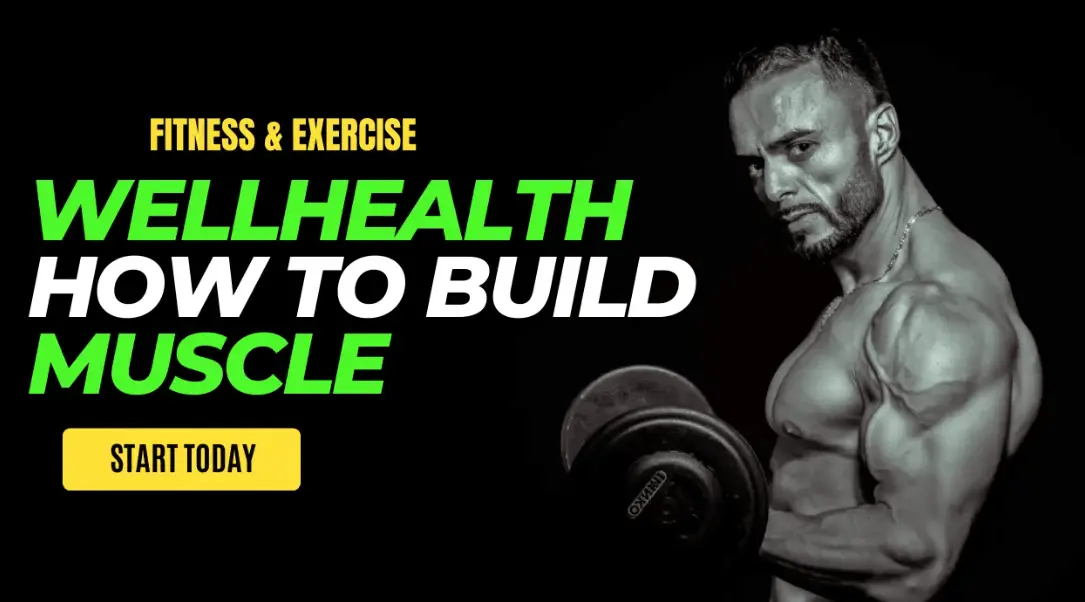Embarking on the journey to build muscle is a transformative endeavor that requires dedication, knowledge, and strategic planning. Whether you’re a novice or have some experience, adopting a smart and healthy approach to muscle growth is crucial. One valuable resource in this endeavor is the Wellhealth How to Build Muscle Tag program. This comprehensive and holistic guide to building muscle is rooted in the latest scientific research, offering proven tips and techniques to help you reach your muscle-building goals more efficiently.
Fundamentals of Wellhealth How to Build Muscle Tag
Muscle building involves a solid understanding of the basic principles governing muscle growth. Scientifically known as hypertrophy, this process occurs when individual muscle fibers increase in size, contributing to overall muscle development. Two primary types of hypertrophy drive muscle growth: Myofibrillar Hypertrophy, which increases the size and number of contractile protein units within muscle fibers, and Sarcoplasmic Hypertrophy, which focuses on the growth of non-contractile components in muscle cells.
Importance of Nutrition in Muscle Building
Nutrition plays a pivotal role in muscle building, and crafting a diet conducive to muscle growth involves understanding the role of macronutrients—proteins, carbohydrates, and fats. Protein, a cornerstone in muscle development, facilitates Muscle Protein Synthesis (MPS). Achieving a caloric surplus, where calorie intake exceeds expenditure, becomes essential to provide energy for rigorous workouts and support muscle growth.
Protein intake must align with individual body weight and training intensity to optimize muscle protein synthesis. Beyond macronutrients, nutrient timing, especially around workouts, influences muscle growth. Pre and post-workout nutrition strategies, such as consuming protein and carbohydrates, contribute to muscle repair and glycogen replenishment.
Micronutrients like vitamins and minerals also play a supportive role in muscle function and overall health. Balancing nutritional aspects creates an environment conducive to sustained growth, enabling individuals to make informed dietary choices aligning with their fitness goals.

Understanding How to Build Muscles
Building muscles is not just about aesthetics; it’s about health and performance. Muscles facilitate movement, support bones and joints, improve metabolism, posture, and confidence. However, muscle building is not easy; it requires a combination of resistance training, nutrition, and recovery.
Choosing the right exercises is crucial, prioritizing compound movements that engage multiple muscle groups simultaneously. Squats, deadlifts, bench presses, and overhead presses are examples of compound exercises that stimulate the release of growth-promoting hormones, fostering overall muscle development.
In addition to compound exercises, incorporating isolation exercises can target specific muscle groups, addressing potential imbalances and ensuring comprehensive muscular growth. Tailoring your exercise selection to align with your fitness goals, emphasizing progressive overload, creates a well-rounded approach fostering balanced and sustainable muscle development.
Preparing a Workout Plan for Building Muscle
The second step to building muscles is preparing a workout plan that suits your goals, schedule, and lifestyle. A structured and organized program dictates the exercises, sets, reps, weight, rest, and training frequency. For example, a well-balanced weekly plan could include upper body push, lower body, upper body pull, full-body strength, cardio, and rest or active recovery days.
Customizing your plan based on preferences, fitness level, and lifestyle is crucial for achieving optimal results. Tailor your workout routine, dietary plan, and consider factors like sleep patterns, stress management, and active recovery techniques to strike a balance that allows effective muscle repair and growth.
| Day | Workout focus | Exercises | Sets x Reps |
| Day 1 | Upper body push | Bench press | 4×8-12 |
Overhead press | 3×10-15 | ||
Incline dumbbell press | 3×12-15 | ||
Tricep dips | 3×12-15 | ||
Push-ups | 3xFailure | ||
Day 2 | Lower body | Squats | 4×8-12 |
Deadlifts | 3×8-10 | ||
Leg press | 3×12-15 | ||
Lunges | 3×12-15 | ||
Calf raises | 4×15-20 | ||
Day 3 | Rest or active recovery | ||
Day 4 | Upper body pulls | Pull-ups or lat pulldowns | 4×8-12 |
Barbell rows | 3×10-15 | ||
Face pulls | 3×12-15 | ||
Bicep curls | 3×12-15 | ||
Hammer curls | 3×12-15 | ||
Day 5 | Cardio and core | 30-45 mins cardio | Cardio |
Planks | 4×30-60s | ||
Russian twists | 3×20 | ||
Leg raises | 3×15-20 | ||
Day 6 | Full body strength | Squat | 4×8-12 |
Deadlift | 3×8-10 | ||
Bench press | 3×8-12 | ||
Pull-ups | 3xFailure | ||
Overhead press | 3×10-15 | ||
Day 7 | Rest or active recovery |
Balancing Volume and Intensity
Balancing volume and intensity is pivotal for optimizing your workout routine. Volume represents the total work performed, including sets, reps, and overall workload, while intensity measures the difficulty or resistance applied during each exercise. Striking the right balance ensures muscles receive adequate stimulation for growth without risking overtraining. Tailor your workout by adjusting volume and intensity based on your fitness level, goals, and recovery capacity, promoting sustainable progress.
Understanding Resistance Training
Resistance training is the cornerstone of any effective muscle-building regimen, emphasizing the systematic application of force to stimulate muscle contraction and growth. Progressive overload, the gradual increase in resistance over time, is essential. Weightlifting, bodyweight exercises, and resistance machines are common modalities for resistance training, with sets, reps, and intensity key factors in optimizing the training stimulus.
Do you want to gain in-depth knowledge about Nutrition to improve your physical well-being? Sign up now for our Nutrition Training!

How to Boost Your Muscle Growth
To maximize muscle growth, two essential factors come into play: recovery and growth supplements. Adequate rest and recovery are paramount, as muscles require time to repair and grow stronger after resistance training. Active recovery, incorporating light aerobic exercises or yoga, promotes blood circulation, efficient nutrient delivery, and alleviates muscle soreness.
Incorporating designated rest days is crucial to prevent overtraining, fatigue, increased injury risk, and hindered muscle growth. Quality sleep, active recovery days, a nutrient-rich diet, hydrotherapy, stretching, and foam rolling are essential components of effective recovery strategies.
Supplements, while not a replacement for a well-rounded diet, can play a supportive role in muscle growth. Protein, creatine, and branched-chain amino acids (BCAAs) are common supplements known for their effectiveness. However, it’s crucial to consult healthcare or nutrition professionals before incorporating new supplements to ensure they align with individual health needs and fitness goals.
Eat a high-protein diet
Eating a high-protein weight loss program is essential for constructing and keeping muscle groups. Protein is the building block of muscle and essential for muscle restoration and recovery.
There are many different ways to eat a high-protein diet. Some good sources of protein include:
- Lean meats, consisting of fowl, turkey, and fish
- Eggs
- Dairy merchandise, together with milk, yogurt, and cheese
- Legumes, inclusive of beans, lentils, and peas
- Nuts and seeds
- Protein powder
It is crucial to pick numerous protein sources to make certain that you are getting all of the important amino acids. Amino acids are the constructing blocks of protein, and they are vital for muscle increase and restoration.

Here are some tips for eating a high-protein diet:
- Include a supply of protein at each meal and snack.
- Choose lean protein sources over high-fat protein assets.
- Combine protein with complicated carbohydrates and healthy fats to create a balanced meal.
- Use protein powder to complement your weight loss program, particularly in case you are suffering to meet your protein needs through food by yourself.
Here is a sample high-protein meal plan for one day:
Breakfast:
- Oatmeal with berries and nuts
- Hard-boiled eggs
- Greek yogurt with fruit and granola
Lunch:
- Salad with grilled bird or fish
- Quinoa with black beans and greens
- Lentil soup
Dinner:
- Salmon with roasted greens
- Chicken stir-fry with brown rice
- Tofu scrambles with whole-wheat toast.
Snacks:
- Greek yoghurt
- Hard-boiled eggs
- Nuts and seeds
- Protein shake
This is just a pattern meal plan, and you could modify it to suit your nutritional desires and preferences. The most vital element is ensuring you become sufficient protein at some stage.
WellHealth How to Build Muscle Tag: Common Challenges
Embarking on a muscle-building journey is not without its challenges. Understanding how to navigate obstacles is crucial for sustained progress. Common challenges include plateaus and injury prevention.
Breaking through plateaus requires a strategic approach, involving variety in exercises, increasing resistance progressively, and incorporating periodization into training programs. Injury prevention involves warm-ups, proper form, adequate rest and recovery, and listening to your body’s signals.
Also Read : How to check indian bank balance: Easy Steps
Conclusion
In conclusion, the WellHealth How to Build Muscle Tag program offers a comprehensive, holistic approach to muscle building and overall well-being. Setting clear goals, focusing on nutrition, designing a balanced workout program, incorporating mindfulness, ensuring adequate rest, staying consistent, and tracking progress are key elements in achieving muscle-building success. While challenges may arise, understanding and addressing them strategically will contribute to a healthy and sustainable muscle-building journey.




